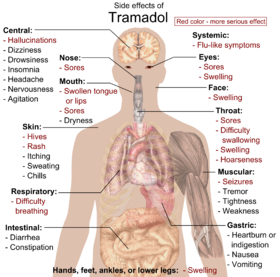What does “mechanism of action” mean? This phrase refers to the effect that a drug substance causes on a living organism or in a biochemical system. The drug substance can produce four main actions: depressing, stimulating, destroying cells and replacing substances.
The desired activities may be cellular membrane disruption, chemical reaction, interaction with enzyme proteins, interaction with structural proteins, interaction with carrier proteins, interaction with ion channels, binding to receptors, hormone receptors, neuromodulator receptors and neurotransmitter receptors.
Although there are many studies performed on thousands of volunteers to know more about analgesics, Tramadol mechanism of action is not completely understood. From studies with animals, at least two complementary mechanisms seem to be valid: binding of parent and M1 metabolite to µ-opioid receptors and weak inhibition of reuptake of norepinephrine and serotonin. The comparative contribution of both Tramadol and M1 to human analgesia depends on the plasma concentrations of each compound. Apart from analgesia, Tramadol may cause a group of symptoms similar to that of an opioid.
The mechanism explained above seems to be a little bit complicated if you are not a scientist but its objective is to clarify why Tramadol can work for treating pain. The different way in which Tramadol provides analgesia with less side effects than the ones caused by other similar products may be explained by Tramadol dual mechanism of action.
In animal and human models both opioid and monaminergic mechanisms contribute to the analgesic efficacy of Tramadol, with the monaminergic mechanism likely accounting for more than half of the analgesic effect.
Tramadol is related to the uptake inhibition of the neurotransmitters noradrenaline and serotonin. Its dual mechanism of action differentiates it from prototypic opioids such as morphine or codeine. This mechanism of action allows Tramadol to have a significant therapeutic importance to improve pain. Tramadol has no clinically related effect on respiratory or cardiovascular parameters. Tramadol may demonstrate particularly useful in patients with poor cardiopulmonary function and in other special patient groups.
Drugs may be classified like any other chemical agent that affects life process. The relationship between the dose administered to a patient and the usefulness on the treatment of the disease he or she suffers from.
Differences between Pharmacokinetics and Pharmacodynamics: The first one is focused on drug quantitative performance in the body. The second one studies the biochemical and physiological effects of the drugs and their mechanism of actions. So, Tramadol mechanism of action explains the effect that Tramadol has on human body functions. In general, drugs can’t create new functions but they are able to modulate the ones that already exist. It has been observed that the drug effects are the result of their relationship with molecules.
Tramadol mechanism of action allows pharmaceutical products that contained Tramadol to produce analgesia that can be compared to Codeine or Dextropropoxyphene. In addition, it produces the beneficial effects that may improve post-surgical pain, obstetric pain, cancer pain and chronic pain of mechanical and neurogenic origin.
Since 2004, there has been a state of uncertainty and controversy about the use of nonsteroidal anti-inflamatory medications and cyclooxygenase (COX)-2 inhibitors, so other analgesics have started to be used for treating moderate to severe pain. This is Tramadol case. Although it was launched in 1977, new uses have been discovered for this active principle.
At the same time, products manufactured with Tramadol may be habit forming. Patients should not take more doses than the ones recommended by their physicians. On the other hand, if they feel that Tramadol mechanism of action is not acting properly, they should contact their healthcare providers immediately.
Because of its mechanism of action, Tramadol may be coadministered with other analgesics, especially those with peripheral action. Drug substances that depress CNS function may enhance the sedative result of Tramadol. When facing a treatment to get pain management, patients should know everything about the drug they will use. Physicians are in charge of providing them with the necessary information to make them feel more confident.
Tramadol mechanism of action is available for those patients who need relief for their pain and suffering. This “mechanism” seems to really “act” as a loyal ally.

